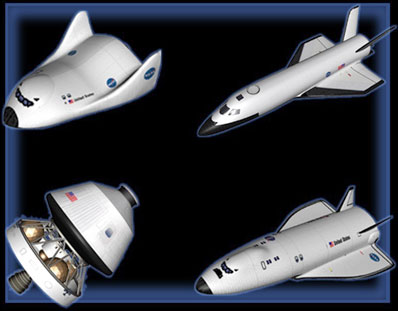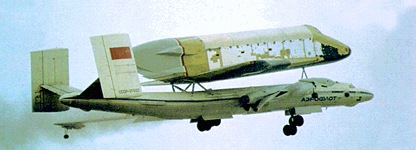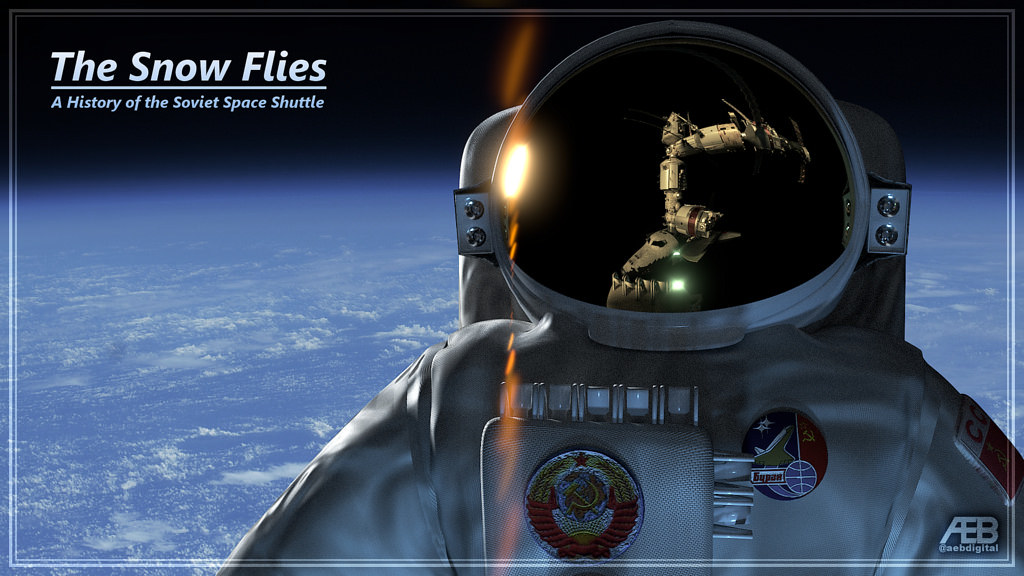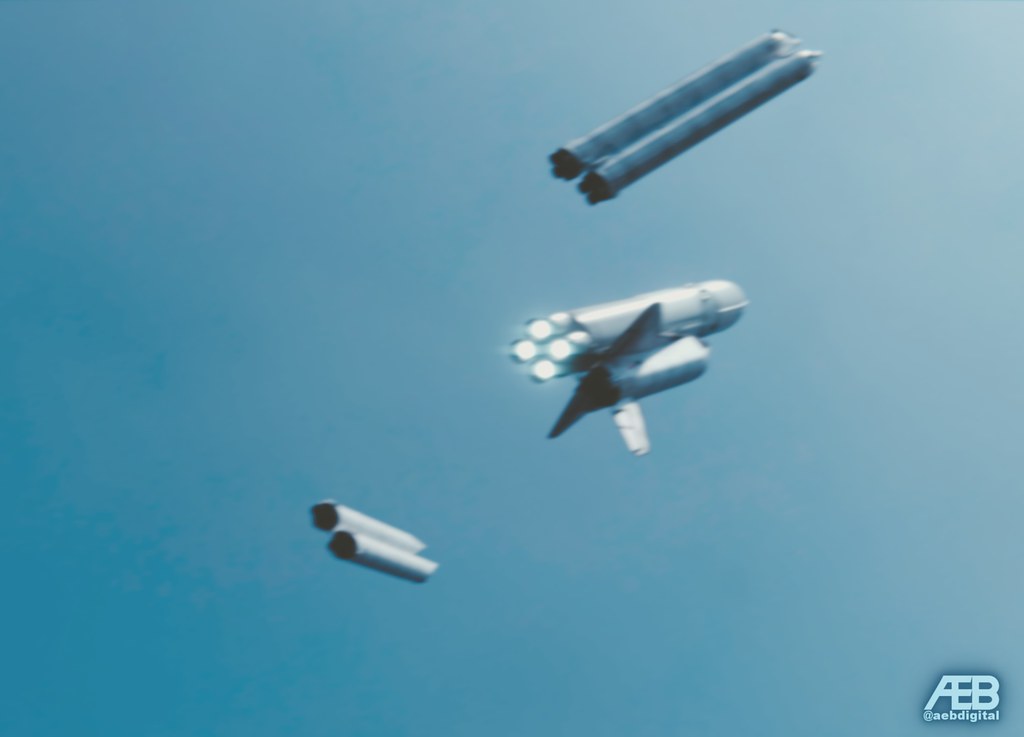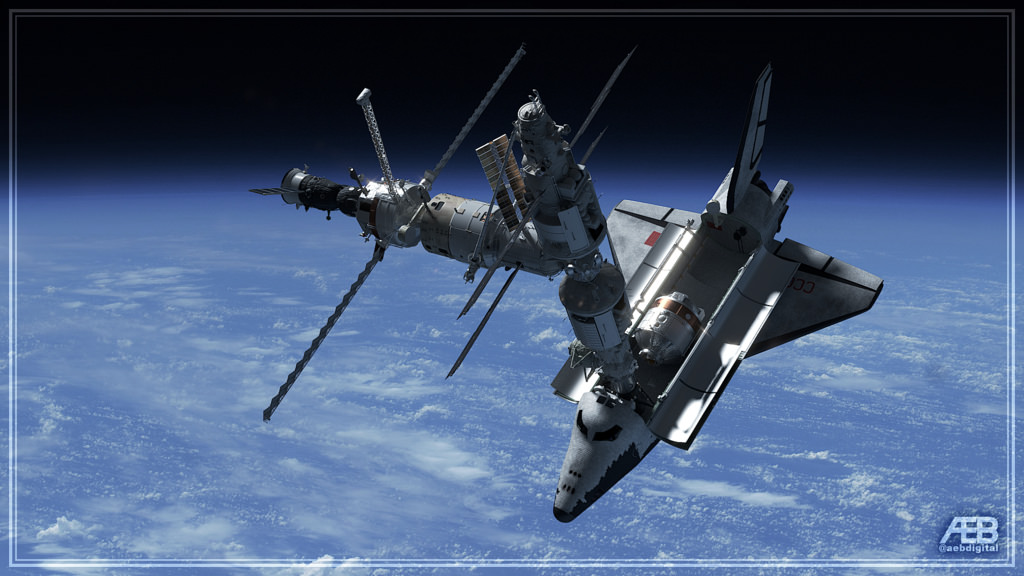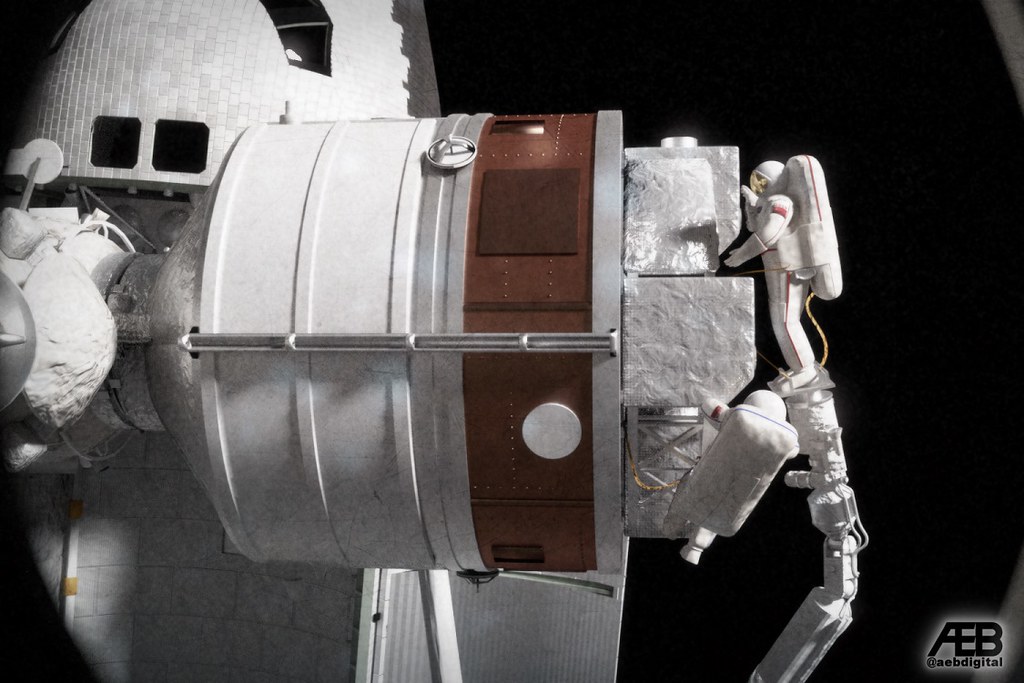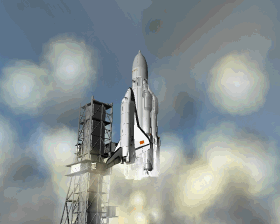Mission 1K2: Buran Flies Again, March 1995
The Decision to Fly
Unlike its US counterpart, it had always been intended that the Soviet space shuttle would undergo multiple unmanned launches before risking a crew. The scars of the Soyuz 1 and Soyuz 11 disasters were still fresh in the minds of many, and Soviet space managers had watched in horror as Bob Crippen and John Young had climbed aboard Columbia for the very first launch of the STS complex in 1981. The aftermath of the 1986 Challenger disaster, which amongst other things had highlighted the lack of escape options for crews of the American shuttle, re-enforced the Soviet view that their own space shuttle would have to prove itself in an automatic mode before any cosmonaut lives would be risked.
This cultural imperative delaying a crewed launch was then further enhanced by budgetary realities, which meant that neither of the two operational orbiters could be fitted with the necessary systems to support a full-up crewed mission for many years. However, by 1994, with three automatic launches and landings successfully completed and with spacecraft 1K Buran finally upgraded with all the requisite systems, the go-ahead was given for mission 1K2, the first manned launch of the Energia programme.
The Ship
Buran had made the first orbital flight of the Soviet shuttle programme in 1988, but six years later she was a very different ship. Like her sister orbiter Burya, Buran now had all of the power, thermal control and avionics systems needed for missions of up to eight days duration. Buran’s Command Compartment (KO), the flight deck of the spaceplane, was now fitted out with a full array of command consoles and display units, all linked to the main Biser-4 computers via the Adonis display processor. These control systems had all undergone extensive testing and debugging in the OK-KS electrical analogue test model at Kaliningrad before being integrated with Buran at Baikonur and then subjected to even more tests.
In a further change from her maiden flight, Buran’s KO now contained two K-36RB ejection seats, one each for the commander and pilot. These were modifications of the K-36 family of seats used in all Soviet high performance aircraft, customised to allow the cosmonauts to escape at any point from an on-pad abort up until around T+100s into the mission, when Buran reached 35km altitude at Mach 3.5. The two additional ejection seats that would normally be installed on the flight deck were omitted for mission 1K2 as no mission specialist/flight engineers would be carried on this occasion. Similarly, the mid-deck Habitation Compartment (BO) was left without ejection seats, avoiding the need to relocated the BO’s forward equipment bay to give the seats clear access to the escape hatches aft of the RCS thrusters in the orbiter’s nose.
Although bereft of ejection seats, Buran’s BO was now fitted with sleeping and washing facilities, a small galley, and a number of experiments (including three from ESA and one from NASA) housed in the deck’s equipment bays. Beneath the BO, the Aggregate Compartment (AO) had been upgraded with all the oxygen tanks, condensation and water recyclers, fire suppression, power and other systems that would keep the crew alive and safe during their stay on orbit.
As Mission 1K2 was planned to dock with Mir, Buran’s payload bay was fitted with an SM docking module. However, on this occasion the 37KB instrumentation module that had been carried for all three unmanned shuttle launches was left out. Instead the payload processing technicians in the MIK RN loaded another 37K-based capsule, the 37KT logistics module [1]. Loaded with five tonnes of fresh supplies and experiments for Mir, this module would be swapped out with the Fosvich-2 telescope on Kristall’s lateral APAS-89 port, taking advantage of the shuttle’s heavy payload capability to replace two of the regular Progress cargo missions. Although an expensive way to resupply the station, it would allow an otherwise non-operational test flight to make a positive contribution to the upkeep of the aging space station, as well as testing out techniques for the construction of Mir’s replacement.
The Crew
The cosmonauts chosen to pilot Buran through its first crewed mission were Igor Volk and Magomed Tolboyev. Both had been selected for the shuttle programme as part of the Zhukovsky-based Flight Research Institute’s (LII) team of “civilian” pilots, with Volk being named in the original 1977 group and Tolboyev being added in 1982. Volk had previously piloted the MiG 105.11 “Lapot” test vehicle (part of the abandoned Spiral two-stage spaceplane), and he quickly rose to become the leader of the LII team, who subsequently became known as the “Wolf Cubs” (a play on Volk’s name, “volk” being Russian for “wolf”).
Despite the fact that the Wolf Cubs formed a year later than the Cosmonaut Training Centre’s (TsPK) own team of nine pilots, the LII group came to the fore in 1981, when the Aviation Ministry (MAP) announced they were forming their own cosmonaut team for shuttle missions, in competition with TsPK’s parent Ministry of General Machine Building (MOM). The Wolf Cubs were reassigned to the MAP group and given the task of leading the atmospheric and orbital test flights of the shuttle. This testing began in earnest in 1984 with the Horizontal Flight Test campaign using the BTS-002 “Buran Analogue” aircraft, a scale copy of the planned shuttle orbiter fitted with additional jet engines to enable it to take off under its own power. Volk in particular was heavily involved in this campaign, piloting the vehicle for 15 of the 21 ground and airborne test runs. Both Volk and Tolboyev also spent many hours in simulators at NPO Molniya and at the Orbiter Simulator Building (KTOK) at Star City. Tolboyev also got to see Buran in action close-up when he piloted the MiG-25 SOTN chase plane that had followed Buran on its unmanned return to Baikonur in 1988. That mission had showcased Tolboyev’s piloting skills in an unexpected way as the orbiter had suddenly changed course during its final approach, forcing Tolboyev to make a high-G turn to avoid a possible mid-air collision with the spacecraft.
Despite the earlier decision in 1992 for the 2K1/Soyuz TM-16 docking with Burya to be given to a joint TsUP/Air Force team, by 1993 the MAP Wolf Cubs were once again assigned to lead the manned test flight programme. Volk and Tolboyev were therefore confirmed as the prime crew for mission 1K2 in July 1994, with Viktor Zabolotskiy and Ural Sultanov named as their back-ups. All four cosmonauts now began mission-specific training at Star City and Baikonur, utilising not only the shuttle simulators but also those for Mir and Soyuz. This last was important in case the need should arise to abandon the shuttle in orbit and either wait on Mir for pick-up, or dock with an APAS-equipped “Rescue Soyuz” spacecraft, one of which (serial number 102, designated Soyuz TM-21) would be on standby at Baikonur during the entirety of the mission. Assigned to pilot this potential rescue mission was Eduard Stepanov, TsUP veteran of the Soyuz TM-16 mission that had docked with Burya. If needed, he would be able to launch at 2 days notice, flying his Soyuz solo to dock with Buran and pick up Volk and Tolboyev. In the more optimistic scenario that no such rescue would prove necessary, Stepanov would stand down and his Soyuz would be held for the next planned crew rotation flight to Mir.
Launch
Buran was rolled out to Site 110’s Pad 38 astride Energia Vehicle 5L in early March 1995, keeping the pace of approximately one year between shuttle launches that had held since late 1992. In most respects the roll-out was indistinguishable from the earlier shuttle missions, but the 1K2 did sport one clearly visible difference: instead of the boxy grey containers of the recovery mechanisms, the four Blok-A boosters were a smooth, unblemished white. With recovery and refurbishment of the boosters now deemed uneconomical, the complicated system of parachutes, retro-rockets and landing legs could be omitted, aligning the Blok-A rockets more closely with their Zenit-2 counterparts. Ambitious plans to eventually turn the core stage into a fully re-usable flyback booster had also been abandoned as unrealistic. As the US had discovered with their own shuttle, Soviet engineers were reassessing whether the benefits of re-use were really worth the complications of refurbishment.
The harsh environment at Baikonur meant that the Soviet shuttle underwent almost all of its preparations before roll-out, and so spent less time on the pad than its American counterpart. The main operations left to complete were the loading of cryogens into the orbiter’s fuel cells and ODU propulsion system and the fuelling of the Energia core and booster stages. Fuelling was carried out completely automatically, and so it was not until the rocket was fully loaded early on the morning 14th March that Volk, Tolboyev and their accompanying team of technicians prepared to join the ship on the pad. This would mark the first Soviet manned launch not using a derivative of Korolev’s original R-7 missile, and so the bus took a different route from that which had become standard for more than thirty years. Nevertheless, Buran’s crew still marked the occasion in the traditional manner, with Volk announcing his crew’s readiness for the mission to Defence Minister Morozov[2] before boarding the bus that would take them out to the Raskat complex. Whether or not they also honoured the tradition of stopping the bus halfway to piss on the wheels, as Gagarin is alleged to have done, is unreported in the official press release.
At the base of the pad the cosmonauts and technicians climbed aboard the trolleys that would carry them through an enclosed pipeline to the orbiter access arm on one of the twin fixed service towers flanking the launcher. Once at the top, the team accessed Buran via the hatch in the BO mid-deck, carefully stepping only on marked areas of the “back wall” of the vertically tilted orbiter and ducking through to the KO flight deck. Here Volk and Tolboyev were helped into their ejection seats, the technicians strapping them in firmly and running final checks on the Strizh pressure suits that would protect the cosmonauts in case of cabin pressure failure or a bail-out. This done, the technicians withdrew from the orbiter cabin, sealing the access hatch behind them before once more riding the trolley system to the base of the pad (resisting the urge to take a shortcut through the lower of the two pipes, that housing the emergency escape chute, as many off-duty personnel were rumoured to do for fun).
The countdown proceeded under automatic computer control, leaving little for Volk and Tolboyev to do but respond to radio check requests. The three CRT displays of their Vega-1 control consoles ran through their pre-programmed sequences exactly as the two pilots had seen countless times in the simulator. Despite this veneer of familiarity, both cosmonauts felt the unique tension in their stomachs that told them that this time it was the real thing, that they really were strapped into an ungainly glider hitched to several tanks of highly flammable liquids just waiting to explode. Then, at T-9.9 seconds the sixteen combustion chambers of the four Blok-A boosters lit, transmitting a strong vibration and steady roar through the body of the launcher, heard now for the first time by human passengers. Just five seconds later the hydrogen/oxygen core stage engines added their voice to the cacophony, and Energia/Buran slipped free of the launch pad and rose into the sky at 11:12am Moscow time.
Attaining Orbit
Buran’s second ascent to orbit proceeded as smoothly as her first had, and with almost the same amount of pilot input, with the cosmonauts’ primary duty being to trigger the opening and closing of vents to release trapped air as the spacecraft ascended. This important duty aside, for the shuttle’s human crew the voyage was primarily marked by the steady progression of abort options. After T+1m40s ejection was no longer a possibility, with an Emergency Separation of the orbiter from the stack or a Return Manoeuvre, shutting down and dumping the boosters before turning the core and orbiter back towards Baikonur, being the two viable options (although for many of the cosmonauts and engineers involved “viable” was a relative term, with Emergency Separation in particular seen as being extremely risky).
With Blok-A separation occurring on-schedule at T+2m26s, these two scenarios remained in play, but by T+3m10s the ship had passed beyond the envelope for a Return Manoeuvre, with the option in case of a core engine failure now becoming a Single Orbit Trajectory (equivalent to a NASA Abort to Orbit or Abort Once Around). This remained the primary abort option all the way up until the core engines shut down at T+7m47s, which occurred as planned for mission 1K2. Volk and Tolboyev reported no problems following core stage separation, and a few minutes later the DOM manoeuvring engines fired to put Buran into orbit for the first time in over six years.
Early orbital operations such as the opening of the payload bay doors and deployment of the radiators and ONI antennas proceeded under automatic control, monitored by the two cosmonauts. Volk and Tolboyev spent their first three hours on-orbit running through careful checks of all of Buran’s vital equipment, paying particular attention to the life support systems. Having satisfied both themselves and mission control that there were no significant problems, the pair stripped out of their pressure suits and took a belated lunch in the BO’s new galley. Both later reported amazement at how much larger Buran’s cabin felt than that of the Soyuz spacecraft to which earlier cosmonauts had been accustomed, with weightlessness making it feel larger than even the mock-up cabins in which they had trained.
The afternoon’s activities mainly focussed on performing the necessary burns to move Buran towards a rendezvous with Mir. Communications with TsUP in Kaliningrad were improved over previous missions following the recent launches of the Gelios-11L and 12L “Luch 2” relay satellites, which had replaced the expired Altair 14L. Following an evening meal and use of the wash facilities, the two crewmen set up their sleeping bags in the flight deck and settled in for the evening. Although the flight plan had been for Volk to sleep in the KO whilst Tolboyev used the BO, the cosmonauts preferred to share the flight deck, partially to give them both easy access to the controls in case of emergence, but mainly so Tolboyev would also be able to watch the Earth through the KO’s large windows.
Docking with Mir
The next day was largely uneventful as Buran closed in on Mir, with Buran making her final approach to the station on the morning of 16th March. Unlike the automated docking of Burya on mission 2K2, for Buran’s 1K2 mission the Kristall module remained berthed at the station’s -Y lateral port, with the station forming a large ‘T’ shape in space. The experience of 2K2 had indicated that the off-axis loads of a shuttle docking in that position could easily be compensated for by Mir’s VDU thruster pack, and so the added effort of relocating the module to the axial port was deemed not to be worthwhile. In an additional change since the earlier docking, Kristall’s large solar wings had been relocated to the Kvant-1 module, meaning there was no need to stow them and suffer the subsequent loss of power that had been necessary to accommodate Burya.
In a final, welcome change from the earlier mission, Buran made a smooth and uneventful final approach to Mir, with no reoccurrence of the SBI radar issues that had delayed Burya’s docking. Buran docked at Kristall’s axial APAS port at 09:45 Moscow time on 16th March. Two hours later the hatch between Kristall and Buran’s SM docking module was opened and Volk and Tolboyev shared a traditional welcome of bread and salt with Mir EO-18 crewmen Vladimir Dezhurov and Gennady Strekalov.
The day after the docking, 17th March 1995, saw Magomed Tolboyev take control of Buran’s starboard SBM robot arm and grab the Fosvich-2 X-ray telescope attached to Kristall’s lateral APAS port. The small module had been sealed up ready for removal the previous week, and Tolboyev had no difficulty in detaching it from the station. The task of manoeuvring the telescope to it’s berth in the aft of Buran’s payload bay was complicated by the presence of the 37KT “Oblako” (“Cloud”) cargo module, but Tolboyev was able to successfully deposit Fosvich in the correct place for its latches to secure it to the shuttle, ready for the journey back to Earth.
The 18th saw Tolboyev once again at the RM-5 control console, this time to lift Oblako out of the cargo hold and move it to Kristall’s now-vacant lateral port. This operation also went smoothly, and as a result the go-ahead was given the next day, the 19th, for Volk and Strekalov to perform an EVA to make exterior connections between Oblako and Kristall, as well as confirm that Fosvich was indeed secured to the payload bay structure. The two cosmonauts donned Orlan DMA suits and exited using Buran’s SM hatch. Over the next five hours they completed all assigned tasks, including a test in which Volk attached himself to a special restraint on Buran’s port SBM arm, which Tolboyev then used to move him into position close to the Oblako module.
Return to Earth
19th March marked the final day of Buran’s operations at Mir, with Volk and Tolboyev departing aboard the shuttle at 11:40 Moscow time, five days after launch from Baikonur. Immediately after undocking, the crew started preparations for their return to Earth. The GSP Gyro Stabilisation Platforms were re-aligned with the ZSP star trackers and radio altimeter, after which the ONI antennas were retracted, the payload bay doors closed. Buran was then reoriented to fly tail-first, after which the DOM engines were fired at 14:21 Moscow Time over the Caribbean Sea to de-orbit the shuttle.
Buran dropped below 100 km altitude approximately 35 minutes later, at which point the Auxiliary Power Units (VSUs) activated, feeding hydraulic power to the aerodynamic controls. All of this took place without intervention from Volk or Tolboyev. The two skilled pilots remained for now passengers as Buran’s computer systems ran through the now familiar sequence of automated re-entry actions. They were intended to remain passive until touchdown, only taking control in the event of some failure of the automatic pilot - a situation very different from that of American shuttle pilots, who always flew their craft to a manual touchdown.
Buran entered communications blackout at around 80 km altitude, with contact restored between the cosmonauts and the ground at just under 50 km, at which point the RDS radio rangefinders locked onto the beacons at Baikonur and Buran began manoeuvring to line up with the runway. For this mission, re-entry had been triggered with the shuttle’s orbital track passing almost 550 km southwest of Baikonur, so Buran would have to make up this distance purely through its aerodynamic controls, without the jet engines that had originally been part of the shuttle’s design. However, this was well within the spacecraft’s 1050 km cross-range capability, and Volk and Tolboyev were relieved to see Buran make the necessary turns precisely to program.
As the shuttle dropped from hypersonic to supersonic speeds around 15 km from the runway - with ejection once again becoming an option for the cosmonauts should anything go wrong - Buran turned to take the southerly Heading Alignment Cylinder before exiting lined up on the Yubileynyy runway. At this point the crew decided to deviate from the mission plan, switching from automatic to manual mode for the final descent. This option had been discussed and rehearsed in simulators before the mission, but the controllers at TsUP had preferred to use the tried-and-trusted automatic pilot for the first manned mission rather than risk pilot error ending the mission in disaster. Needless to say, the Flight Research Institute pilots disagreed with this cautious approach, and Volk and Tolboyev had agreed between themselves the previous evening that, should the situation seem stable, Volk would pilot the shuttle himself for the final dozen kilometres.
Under Volk’s expert direction, Buran swooped into the steep 20 degree glidepath before levelling out to 2 degrees. The landing gear was deployed and, with a final flare, Volk put the giant glider gently onto the tarmac. As soon as all three main gear were in contact with the ground, he triggered the braking parachutes and activated the wheel and air brakes (the latter of which had not been used for unmanned landings), bringing Buran to a rest at 15:17 Moscow time. Volk and Tolboyev were privately reprimanded for their deviation from the mission plan in taking manual control, shortly before being awarded Hero of the Soviet Union medals for successfully completing the USSR’s first fully crewed shuttle mission.
+++++++++++++++++++++++++++++++++++++++++++++++
[1] The 37KT is a TTL innovation, but not much of a stretch. It’s basically a Soviet equivalent of the Italian-built logistics modules that the shuttle used to ferry supplies to the ISS (one of which, Leonardo, now permanently attached to the station as a store room). 37KT is smaller, the same size as Mir’s Kvant-1 module, with which it shares a design.
[2] Kostyantyn Morozov was a professional soldier who by 1990 had risen to command an air army in Kiev. IOTL he went on to become the first Defence Minister of independent Ukraine. ITTL he spent a little longer in the armed forces before being appointed the Soviet Defence Minister around 1993, part of a political effort to get more non-Russians (and particularly Ukrainians) into the central government as a counter to pushes for independence.
